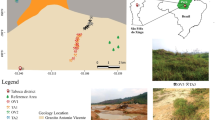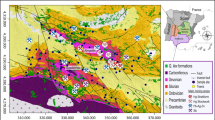Abstract
Lanthanides (rare-earth elements) were quantitatively determined by atomic emission spectrometry/inductively coupled plasma (AES/ICP) in various plants (Picea abies, Vaccinium vitis-idaea, Vaccinium myrtillus, Polytrichum commune, Sphagnum spec., and Hypogymna physodes) collected in the Forest Biosphere Reserve 350 km northwest of Moscow (USSR). Compared with previously established background values for lanthanide elements in central Europe, the rare elements determined in the USSR samples appear in lower concentrations. The lichen Hypogymna physodes can be characterized as an extreme accumulator of lanthanide elements up to a factor of ten compared to the other plant species collected in the Forest Biosphere Reserve. With regard to the lanthanide contents in plants collected in a German reference forest ecosystem, it can be seen, that the German samples represent without exception higher lanthanide values. Leaves of Vaccinium vitis-idaea display contents 3–4 times higher, leaves of Vaccinium myrtillus show concentrations higher by a factor of about 0.3, approximately twice the contents were determined in the German samples of Polytrichum formosum and P. commune, and the values in the German samples of the Sphagnum species are about 3 times that of the Soviet samples. As pointed out for pollution by heavy metals in part I of this series, the Forest Biosphere Reserve is generally characterized by lower contents of lanthanides in the vegetation cover than a comparable forest ecosystem (Grasmoor near Osnabrück, F.R.G.) in central Europe.
Similar content being viewed by others
References
Bowen, H. J. M. 1979. Environmental chemistry of the elements. Academic Press, London.
Cercasov, V. & Heller, R. 1980. Application of 14 MeV neutron activation analysis of the determination of cerium and samarium markers in biological materials. J. Radioanal. Chem. 60: 453–460.
Coleman, N. T. 1970. Accumulation of cerium, yttrium and cesium in plants as affected by their soil chemistry and the aeration of the soil. U.S. Gov. Res. Develop. Rep. 70, 43.
Danne, R. & Fourcy, A. 1970. Detection of rare earths in plants using radioactivation methods — application of the method in geochemical ecology. U.S. Gov. Res. Develop. Rep. 70, 39.
Ernst, W. H. O. & Joosse Van Damme, E. N. G. 1983. Umweltbelastung durch Mineralstoffe. Gustav Fischer Verlag, Stuttgart.
Fryer, B. J. & Taylor, R. P. 1987. Rare earth element distribution in uranites: implications for ore genesis. Chem. Geol. 63: 101–108.
Henzler, T. E., Korda, R. J., Helmke, P. A., Anderson, M. R., Jimenez, M. M. & Haskin, L. A. 1974. An accurate procedure for multi element neutron activation analysis of trace elements in biological materials. J. Radioanal. Chem. 20: 649–663.
Irgolic, K. J. & Martell, A. E. (eds.) 1985. Environmental inorganic chemistry. VCH-Publisher, Weinheim.
Iyengar, G. V. 1989. Elemental analysis of biological systems, Vol. 1: Compositional and methodological aspects. CRC Press, Boca Raton.
Jiao, Kui, Zhang, Manping & Gao, Xiaoxia 1982. Electroanalytical determination of microamount of rare earth elements in plants by using polarographic complex adsorptive waves. Beijing Daxue Xuebao, Ziran Kexueban 6: 77–84.
Kabata-Pendias, A. & Pendias, H. 1984. Trace elements in soils and plants. CRC Press, Boca Raton, Florida.
Kovacs, M., Nyary, I. & Toth, L. 1984. The microelement content of some submerged and floating aquatic plants. Acta Bot. Hung. 30: 173–186.
Koyama, M., Shirakawa, M., Takada, J., Katayama, Y. & Matsubara, T. 1987. Trace elements in land plants: concentration ranges and accumulators of rare earths, barium, radium, manganese, iron, cobalt and heavy halogens. J. Radioanal. Nucl. Chem. 112: 489–506.
Laul, J. C., Weimer, W. C. & Rancitelli, L. A. 1979. Biogeochemical distribution of rare earths and other trace elements in plants and soils. In: Ahrens, L. H. (ed.), Origin and distribution of the elements. Pergamon Press, Oxford, 819–827.
Lepel, E. A. & Laul, J. C. 1987. Trace rare earth element analysis of IAEA hair HH-1, animal bone H-5, and other biological standards by radiochemical neutron activation. J. Radioanal. Nucl. Chem. 113: 275–284.
Li, Wanxuan, Xiao, Yueying & Yu, Ximao 1984. Direct spectrophotometric determination of the cerium group of rare earth elements in plants and seeds with tribromoarsenazo. Yingyong Huaxue 1: 59–61.
Lieth, H. & Markert, B. 1988. Aufstellung und Auswertung ökosystemarer Element-Konzentrations-Kataster. Springer-Verlag, Berlin, Heidelberg, New York.
Lieth, H. & Markert, B. (eds.) 1990. Element Concentration Cadasters in Ecosystems, Methods of Assessment and Evaluation. VCH-Publisher, Weinheim, 448 pp.
Liu, Zheng 1981. Rare earth elements in soils and plants. Turangxue Jinzhan 1: 17–21.
Markert, B. 1987. The pattern of distribution of lanthanide elements in soils and plants. Phytochemistry 26: 3167–3170.
Markert, B. 1991a. Inorganic chemical investigations in the Forest Biosphere Reserve near Kalinin. I. Mosses and peat profiles as bioindicators for different chemical elements. Vegetatio (in press).
Markert, B. 1991b. Instrumentelle Multielementanalyse in Pflanzenproben. VCH-Publisher Inc., Weinheim and New York (in press).
Markert, B., Piehler, H., Lieth, H. & Sugimae, A. 1989. Normalization and calculation of lanthanide element concentrations in environmental samples. Radiat. Environ. Biophysics 28: 213–221.
Markert, B. & Wtorowa, W. 1991. Inorganic chemical investigations in the Forest Biosphere Reserve near Kalinin, USSR. III. Comparison of the multielement budget with a forest ecosystem in Germany (in prep.).
Markert, B. & ZhangDe, Li 1991. Natural background concentrations of rare earth elements in a forest ecosystem. The Science of the Total Environment 103: 27–35.
McKenzie, H. A. & Smythe, L. E. (eds.) 1988. Quantitative trace analysis of biological materials. Elsevier, Amsterdam, New York, Oxford.
Masuda, A., Nakamura, N. & Tanaka, T. 1973. Fine structure of mutually normalized rare earth patterns of chondrites. Geochim. Cosmochim. Acta 37: 239–248.
Nance, W. B. & Taylor, S. R. 1976. Rare earth element patterns and crustal evolution. I. Australian post-Archean sedimentary rocks. Geochim. Cosmochim. Acta 40: 1539–1551.
Nance, W. B. & Taylor, S. R. 1977. Rare earth element patterns and crustal evolution. II. Archean sedimentary rocks from Kalgoorli, Australia. Geochim. Cosmochim. Acta 41: 225–231.
Nevoral, V. 1988. Auftreten von Spuren seltener Erden in Mineralwässern. Balneol. bohem. 17: 18–25.
Nriagu, J. O. & Pacyna, J. M. 1988. Quantitative assessment of worldwide contamination of air, water and soils by trace metals. Nature 333: 134–139.
Ohno, S., Asprer, G. A., Hongo, S., Suzuki, M. & Watanabe, S. 1971. Determination of Europium in biological materials by neutron activation analysis. Radioisotopes 20: 224–227.
Okada, Y. & Hirai, S. 1984. Trace elements in edible plants. Musashi Kogyo Daigaku Genshiryoku Kenkyusho Kenkyu Shoho 9: 142–146.
Qi, Daquan & Cheng, Li 1985. Spectrochemical study on the distribution of rare earth contents in plants. Beijing Daxue Xuebao, Ziran Kexueban 6: 68–74.
Qi, Daquan, Gong, Xiaowei & Zhao, Kunghua 1984. Spectrochemical determination of rare earth in plants including tea plants. Guangpuxue Yu Guangpu Fenxi 4: 36–40.
Qi, Tianqing, Liu, Puling, Shong, Caichi & Wang, Xibin 1984. Absorption, transfer and distribution of rare earth elements in plants. Zhongguo Xitu Xuebao 2: 94–98.
Sansoni, B. 1987. Multi-element analysis for environmental characterization. Pure & Applied Chemistry 59: 579–610.
Sugimae, A. 1980. Atmospheric concentrations and sources of rare earth elements. Japan, Atmospheric Environment 14: 1171–1175.
Sugimae, A. 1990. Sample preparation for multi-element analysis of environmental samples. In: Lieth, H. & Markert, B. (eds.). Element concentration cadasters in ecosystems. VCH-Verlagsgesellschaft mbH, Weinheim, New York, pp. 107–117.
Taylor, S. R. & Gorton, M. P. 1977. Geochemical application of spark source mass spectrography. II. Element sensitivity, precision and accuracy. Geochim. Cosmochim. Acta 41: 1375–1380.
Tjioe, P. S., Volkers, K. J., Kroon, J. J. & De, Goeij, J. J. M. 1983. Distribution patterns of rare earth elements in biological materials evaluated by radiochemical neutron activation analysis. J. Radioanal. Chem. 80: 129–139.
Tsukada, M., Yoshikawa, H., Yanaga, M., Endo, K., Nakahara, H. 1988. Dysprosium-156 as an activable yield tracer for determination of rare earth elements in biological materials by neutron activation analysis. J. Radioanal. Nucl. Chem. 125: 351–366.
Wu, Zhaoming, Tang, Xike, Gao, Xiaoxia, Jiao, Kui & Zhang, Manping 1983. Effect of rare earth elements on yield increase in agriculture. I. Preliminary studies on distribution and content of rare earth elements in plants. Zhongguo Xitu Xuebao 1: 70–75.
Yliruokanen, I. 1975a. A chemical study on the occurrence of rare earths in plants. Ann. Acad. Sci. Fenn. Ser. A II Chem. 176: 1–28.
Yliruokanen, I. 1975b. Uranium, thorium, lead and yttrium in some plants growing on granitic and radioactive rocks. Bull. Geol. Soc. Finl. 47: 71–78.
Zeisler, R., Stone, S. F. & Sanders, R. W. 1988. Sequential determination of biological and pollutant elements in marine bivalves. Anal. Chem. 60: 2760–2765.
ZhangDe, Li 1988. Inductively coupled plasma-spectrographic determination of trace rare earth in waters, soils and plants. Fenxi Shiyanshi 7 (3): 61–62.
Author information
Authors and Affiliations
Rights and permissions
About this article
Cite this article
Markert, B., de Li, Z. Inorganic chemical investigations in the forest biosphere reserve near Kalinin, USSR. Vegetatio 97, 57–62 (1991). https://doi.org/10.1007/BF00033901
Accepted:
Issue Date:
DOI: https://doi.org/10.1007/BF00033901




